ONE FIELD DRESSING IS NOT ENOUGH

THE FORT BRAGG POST, UPDATED FOR 2005
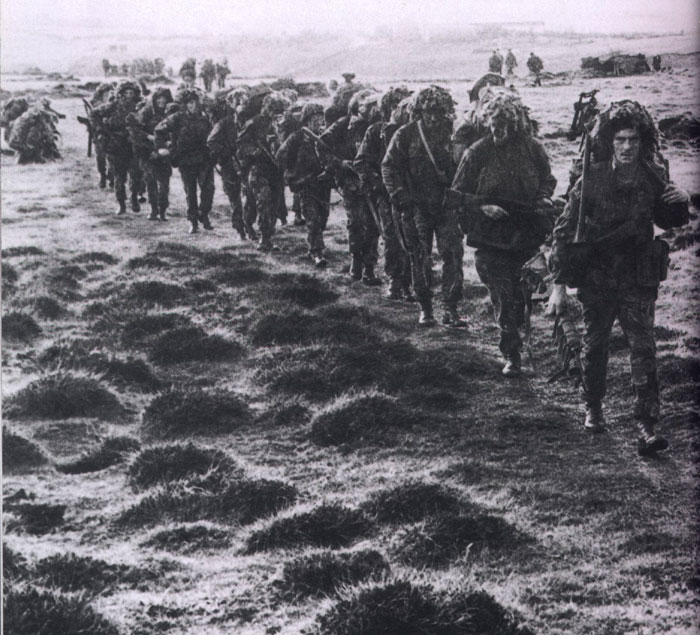
There were no helicopters; destroyed by missile attack while being on a vulnerable ship. With only puny 5" naval guns from destroyers at great risk to themselves from Exocet antiship missiles--and a handful of 105mm towed guns, the British Paratroops of Colonel H. Jones have to march across the Falklands Islands with everything on their backs; they will have to overcome stiff Argentine positions, dug-in on the rocky high ground. If a "Para" gets hit he'll have to be patched-up on the spot, there will be no MEDEVAC choppers to fly him to a field hospital. If the bleeding is not stopped, the man dies.
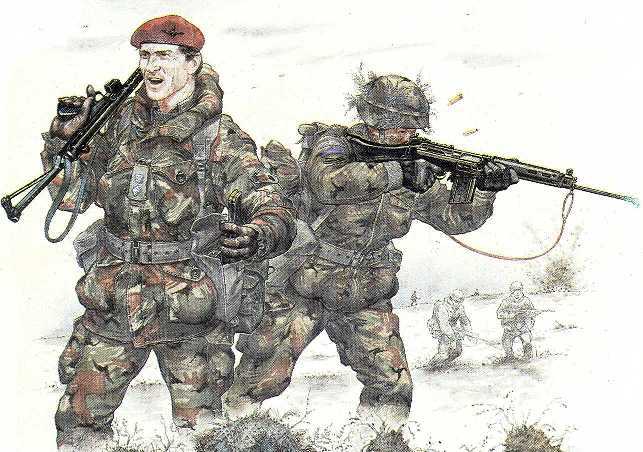
Artwork by Paul Chappell
Colonel Jones leads his men into the attack uphill. He is cut-down by machine gun fire, but his battalion defeats the "Argies", at great cost.
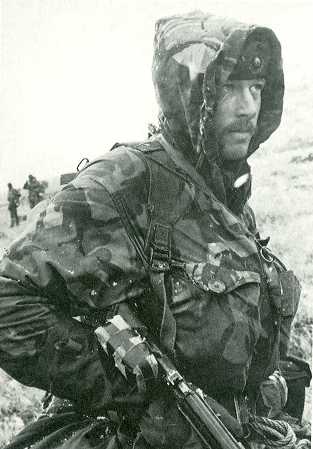
Each man has TWO field dressings taped to his rifle buttstock to quickly stop the bleeding of both entrance and exit wounds, saving hundreds of lives.
U.S. Army SOP is one field dressing in case on the LBE shoulder straps which all combat trauma experts agree is not enough, dressings quickly saturate with blood and even 2 is not enough: the canteen cover should be redesigned for an outer pouch to hold 2 dressings and/or a cravat. Until then, 2 dressings should be taped to the rifle/weapon stock with "100 mph" tape for ready access and to act as a cheek pad. At the tape's end fold to create a "pull-tab". Its unrealistic to think Combat Life Savers (CLSers) will be able to carry enough field dressings for their entire unit in their CLS bags.

6 years after we posted the idea of taping a field dressing to the rifle buttstock, U.S. Army Center for Lessons Learned (CALL) "discovered" the technique for their 2002 Afghanistan report:
http://call.army.mil/products/handbook/02-8/02-8ch2.htm
"Tape a spare field dressing to the sling at the stock, using a single strip of wide cloth tape with a quick-release tab".
The British Airborne's plight on the Falklands is not unique: all of our Iowa-class battleships are in mothballs or being turned into museums (unless Senator Sam Nunn of Georgia and John Warner of Virginia's efforts to keep 2 ships with their 16" guns available succeed) so our Airborne will only have what it takes--with coastal defenses, mines, our Navy is unlikely to risk billion-dollar Aegis cruisers into 5" gun range for Paratrooper/marines ashore. Paratroopers maneuvering against enemy fire, if hit in the chest without adequate rifle-caliber resistant body armor or gunshields will need plastic to re-establish an air-tight seal.
This wound is illustrated in the George Clooney film, "Three Kings" when Mark Wahlberg's character is hit in the chest by an AKM 7.62mm x 39mm round. Wiki says the following on such a wound:
http://en.wikipedia.org/wiki/Pneumothorax
Chest woundPenetrating wounds require immediate coverage with an occlusive dressing, field dressing, or pressure bandage made air-tight with petroleum jelly or clean plastic sheeting. The sterile inside of plastic bandage packaging is good for this purpose; however any airtight material, even the cellophane of a cigarette pack, can be used. A small opening, known as a flutter valve, needs to be left open, so the air can escape while the lung reinflates. Any patient with a penetrating chest wound must be closely watched at all times and may develop a tension pneumothorax or other immediately life-threatening respiratory emergency at any moment. They cannot be left alone.
If left untreated, the simple pneumothorax can become a pressure one.
http://en.wikipedia.org/wiki/Tension_pneumothorax
A tension pneumothorax is a life-threatening condition that results from a progressive deterioration and worsening of a simple pneumothorax, associated with the formation of a one-way valve at the point of rupture.[1]Upon inspiration, when the pressure inside the chest and pleural cavity lessens as a result of the respiratory muscles increasing chest dimensions, air is sucked in through this one way valve, into the pleural space. Because expiration is a passive process, there is an insignificant amount of pressure created to force the air back out of the pleural cavity. This condition over time results in a gradual accumulation of air to the degree that it begins to put pressure on the mediastinum, compressing the heart and decreasing cardiac output due to the reduced amount of diastolic filling of the ventricles, and also putting pressure against the trachea, deviating it from the midline. Because of the increased thoracic pressure, venous return to the heart is decreased, causing a backup of blood into the venous system, as is evidence by distended jugular veins.[1]
www.brooksidepress.org/Products/OperationalMedicine/DATA/operationalmed/MOLLEBag/ChestSeal.htm
A penetrating chest wound may lead to several significant problems. One immediate issue is the open pneumothorax that leads to collapse of the lung.
In this condition, air can move freely in and out of the pleural space. When breathing in, air is easily pulled into the pleural space, rather than the lung. When breathing out, the air is expelled from the pleural space, and the lung collapses.
A one-way chest seal quickly fixes this problem, by keeping air from moving into the pleural space but allowing it to escape. After several breaths, the lung will be re-expanded and functional. The Asherman Chest Seal is pre-packaged in a sterile bag with a 4 X 4 gauze sponge.

* Use the 4 X 4 to clean and dry the area around the chest wound.
* Peel off the protective paper liner, exposing the adhesive.
* Place the chest seal over the wound.
* With each breath more air will be forced out through the flutter valve, which also keeps outside air from returning to the pleural space.
*
If an Asherman Chest Seal is not available, a variety of field-expedient chest seals can be quickly made.

Shown here is a plastic wrapper from a small battle dressing, covering the wound and taped to the chest with adhesive tape. Note that a small portion of the wrapper is not taped, to allow air to escape. Moisture (blood, pleural fluid, etc.) underneath the plastic holds the plastic against the chest wall and keeps air from coming back into the pleural space during inhalation.
Any plastic-like material can work well for this purpose, including Ziplock bags, cellophane wrappers, and latex gloves.
Dressing Chest Wound Seal 10S
Weight: .03 pounds
NSN: 6510-01-408-1920
Current CTT manuals incorrectly teach Soldiers to tape all 4 sides of a "sucking chest" wound that when closed all around causes pressure to build that can collapse the lung around the heart and kill Soldiers. All Soldiers--not just combat life-savers need to be trained to seal only 3 sides of a pressure dressing to create a "flutter valve" so pressure is released during breathing. A new field dressing with this valve built-in has been created by retired U.S. Navy SEAL HM2 (E5) Rick Asherman, a Panama combat veteran while assigned to U.S. Army Medical Command at Fort Sam Houston, Texas. They are available from his own company with very high quality guaranteed:
Richard "Ric" Asherman
601 Yellowstone Ave.
Cody, Wyoming 82414
(307) 587-7099
asherman@codylabs.com
Or made under contract:
Armstrong Medical Co.
PO Box 700
Lincolnshire IL 60069
1 (800) 323-4220 or (708) 913-0138
Order using the U.S. Government Blanket Purchasing Agreement # SP020095A9059 and part # AE1700; cost is $95 for a box of 10.
The higher cost, pressure-release field dressing should be inside a compass/dressing pouch on the Soldier's LBE/TLBV shoulder area secured by bicycle inner-tube "Ranger Bands" for quick retrieval in event of sucking chest would with the basic field dressings in quantity (for non-pressure release wounds--2 on the buttstock as an expedient cheek pad to speed sight alignment/picture for snap shooting accuracy that hits the enemy, and one dressing under the magazine pouch top flaps using a sewn-in retainer strap which helps silence metal magazine rattle. An improved canteen cover/mag pouch with larger outer pocket would increase field dressing numbers when we realize the issue canteen cover is obsolete and unreliable due to metal snap failure and the fumbling required to access canteens.
The new 2.4 pound SOF WARFIGHTER INDIVIDUAL FIRST AID KIT, COMPLETE (SOF-W-IFAK) NSN: 6545-01-540-5695 (CB), 6545-01-540-5661 (ACU) , SK-11300-CB, SK-11300-ACU

IFAK is canteen-cover sized to carry the Israeli field dressing which has a back pad for exit wound sealing.
www.skedco.com/detail.aspx?categoryID=2&subID=4&sku=SK-11300
www.skedco.com/documents/IFAK%20Brochure%20(06AUG07).pdf
STATEMENT OF NEED: Combat Casualties are a "Reality of War". Approximately 15% of all combat casualties that survive initial wounding die before reaching definitive care from causes that are potentially correctable.This percentage can be reduced through dynamic First Responder Self/Buddy-Aid training emphasizing TCCC combined with equipping each SOF WARFIGHTER with a "comprehensive" IFAK for use at the point of wounding.

SUB-COMPONENT LISTING:
Pouch, SOF Warfighter IFAK, SK-1130-ACU/CB
Pouch, Warfighter Tourniquet, SK-WT-P
Panel, Leg, Ambidextrous Medical-Utility, SK-WIFAK-01
Extreme Medicine(tm) First Responder-Self/Buddy-Aid Immediate Action Cards, XMS-10
SOFT-Tourniquet
Tactical Defender Nitrile Gloves, XL (2 Pr)
Bandage Shears
Wipes, Vionex Antimicrobial (2)
28 Fr NPA/Lubricant
Shield, Face, Laerdal
Gauze, Petrolatum
Asherman Chest Seal
Catheter, 14 ga X 3.25"
Bandage, Emergency, 6" w/Mobile Pad
Gauze, Z-Pack
Cravat, Camovat
Tape, Surgical, 3"(tm)
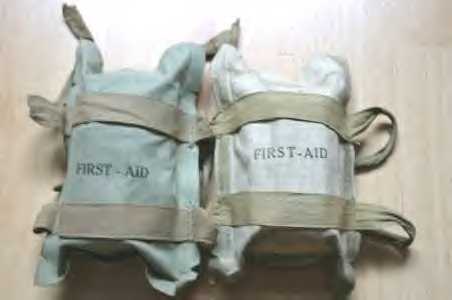
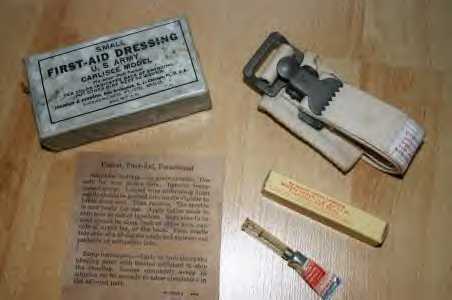
Paratroopers hit by high-velocity projectiles not defeated by armor often have both entrance and exit wounds--one field dressing is not enough. WWII Paratroopers had a couple on their helmets and so should we.

In fact, as you can see above, the WW2 Paratrooper's field dresssings came with powerful morphine pain killer syrettes ready to inject into a badly wounded man and had a simple strap to make an effective tourniquet. We are actually today LESS equipped to face battlefield realities than we were almost 7 decades ago! We need to not only have a morphine syrette, we need a length of rubber or nylon to make a tourniquet as standard with twin dressing packs. Quik-Clot anti-coagulant powder needs to be on every Soldier's LBE or in a designated BDU/ACU pocket.
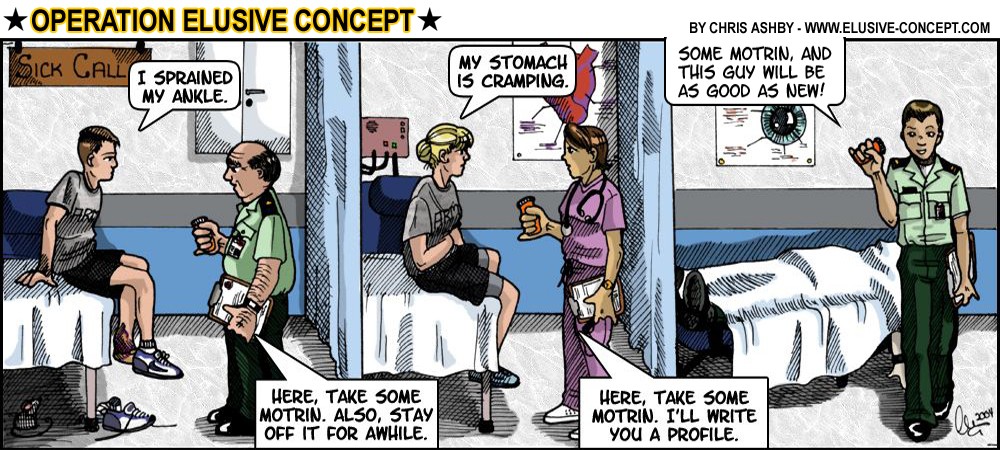
 RETURN TO U.S. ARMY AIRBORNE EQUIPMENT SHOP
RETURN TO U.S. ARMY AIRBORNE EQUIPMENT SHOP